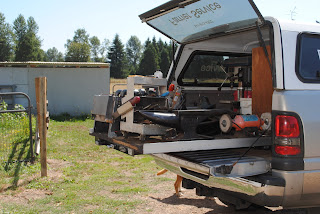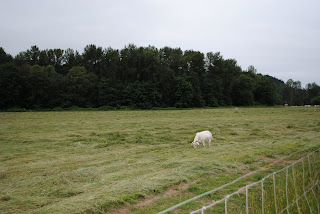
It was time for Shasta and Rebel to get their feet trimmed. Shasta had developed a nasty, horizontal crack midway up her hoof.
Sometimes cracks like this are the result of an abscess. The fix is to have a farrier trim the hooves and put a horseshoe on the foot with the crack until the hoof grows out. Horse hooves are like our fingernails. They continue to grow and periodically need to be trimmed. Horse hooves need regular trimming or problems can develop.

Farriers are the experts on horse feet. Many farriers are trained in the barefoot method, where the horse goes without shoes, like wild horses. Unlike wild horses, these horses need to have their feet professionally trimmed on a regular schedule. Farriers are also trained in the art of shoeing a horse.
A farrier was called to help Shasta's problem. He arrived with all his equipment.
Shasta's owner held her lead rope while the farrier went to work. He used a hoof knife to clean the sole of the foot. There is no pain in a healthy hoof. If a farrier does find
 pain he has found an abscess and will treat the problem. Shasta's foot was healthy, except for the crack.
pain he has found an abscess and will treat the problem. Shasta's foot was healthy, except for the crack.He set to work cleaning the sole with a special knife. It has a small blade that's curved at the tip and very sharp. The old sole is dug out, back to fresh, new sole. It's much like the callouses we get on our hands and feet. They can be shaved back to fresh skin without pain. But get too close to new tissue and look out. The same is true of horse feet.

Then the farrier used nippers to cut the hoof wall. The hoof wall is much like our fingernails only it's much thicker and tougher. Like our fingernails, the horse feels no pain in the process. Here the farrier is using a special stand to hold the foot at the angle he needs to do it right.
Anyone can take a pair of nippers and trim a horse's hoof. But farriers are trained professionals who understand the whole hoof and how it affects the whole horse. A badly trimmed hoof can throw off a horse's gait and cause them to become lame. A hoof sole that's been dug out too close can lead to multiple problems, including pain on standing and moving. Horses are meant to move and can even sleep while standing. Any horse who lays down because of painful feet is open to serious health problems.

This is what a healthy, freshly cleaned and trimmed hoof looks like. The farrier studies the hoof, making sure it's balanced and even.
The last step for Shasta was a new pair of horse shoes on both front feet. Shoeing both feet will help her stay balanced. The shoe on the cracked foot will ensure that the crack won't grow larger as the hoof grows out. It will take about eight months for the hoof wall to grow out so the crack can be trimmed off. Then Shasta will have four good, whole feet to stand, run and sleep on!














